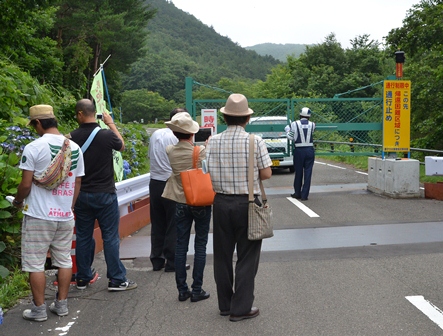Participants of World Conference against Atomic & Hydrogen Bombs inspect Fukushima disaster zone
Aug. 2, 2013
by Jumpei Fujimura, Staff Writer
On July 29, about 60 participants of the World Conference against Atomic & Hydrogen Bombs, organized by the Japan Congress Against A- and H-Bombs (Gensuikin) and other organizations, visited areas that have been severely impacted by the accident at the Fukushima No. 1 (Daiichi) nuclear power plant, including the town of Iitate in Fukushima Prefecture. Former residents and employees of municipal offices expressed anxiety and anger at the slow process of rehabilitation and reconstruction.
In the town of Iitate, the conference participants viewed a barricade on the border of a “no-entry zone,” where the level of radiation exposure exceeds a total dose of 50 millisieverts per year. They also visited an elementary school located in a “restricted-residence zone,” where the dose is larger than 20 millisieverts but does not exceed 50 millisieverts. They used a dosimeter and saw the readings rise sharply.
Koichi Sugano, 49, who had been a resident of the Nagadoro area, which is now a no-entry zone, guided the visitors. Mr. Sugano, who currently lives in the city of Fukushima, told them that an area thick with chest-high weeds was once rice paddies and a playing field. “This land has been left to become a wasteland because of the accident at the nuclear plant,” explained Mr. Sugano. “How can we accept the plants restarting their operations when nothing is being done about this land?”
In Minamisoma, Ryuichi Suzuki, 44, an employee of the city government, gave a presentation, describing how the number of people who reside in the city has decreased by 35 percent, to 46,000 people, since the accident. He also reported on the number of evacuees still living outside the city--15,000 people--and said that businesses and medical facilities have been slow to resume their services.
“The accident at the nuclear plant has affected us all profoundly,” Mr. Suzuki said. “My heart aches when I think of the hardships that people are experiencing. No matter how desperately they wish to go home, they can’t. The level of anxiety is increasing, not decreasing.”
(Originally published on July 30, 2013)
On July 29, about 60 participants of the World Conference against Atomic & Hydrogen Bombs, organized by the Japan Congress Against A- and H-Bombs (Gensuikin) and other organizations, visited areas that have been severely impacted by the accident at the Fukushima No. 1 (Daiichi) nuclear power plant, including the town of Iitate in Fukushima Prefecture. Former residents and employees of municipal offices expressed anxiety and anger at the slow process of rehabilitation and reconstruction.
In the town of Iitate, the conference participants viewed a barricade on the border of a “no-entry zone,” where the level of radiation exposure exceeds a total dose of 50 millisieverts per year. They also visited an elementary school located in a “restricted-residence zone,” where the dose is larger than 20 millisieverts but does not exceed 50 millisieverts. They used a dosimeter and saw the readings rise sharply.
Koichi Sugano, 49, who had been a resident of the Nagadoro area, which is now a no-entry zone, guided the visitors. Mr. Sugano, who currently lives in the city of Fukushima, told them that an area thick with chest-high weeds was once rice paddies and a playing field. “This land has been left to become a wasteland because of the accident at the nuclear plant,” explained Mr. Sugano. “How can we accept the plants restarting their operations when nothing is being done about this land?”
In Minamisoma, Ryuichi Suzuki, 44, an employee of the city government, gave a presentation, describing how the number of people who reside in the city has decreased by 35 percent, to 46,000 people, since the accident. He also reported on the number of evacuees still living outside the city--15,000 people--and said that businesses and medical facilities have been slow to resume their services.
“The accident at the nuclear plant has affected us all profoundly,” Mr. Suzuki said. “My heart aches when I think of the hardships that people are experiencing. No matter how desperately they wish to go home, they can’t. The level of anxiety is increasing, not decreasing.”
(Originally published on July 30, 2013)







